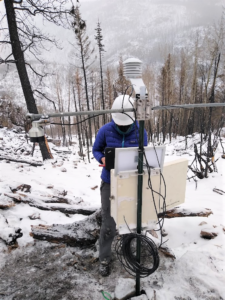
Snowpack is a victim of increasing western wildfires, causing some regions to have less peak snow accumulation and reducing the number of days snow is on the ground, according to new Colorado State University research.
In burned forests, trees no longer block as much energy from the sun and burned timber sheds soot, making snow melt quicker in the late snow zone of mountain ranges – the highest area where snow is deepest and lasts the longest. Less snow could mean less water for a region that relies heavily on mountain snowpack for water supply, according to researchers.
At the highest elevations, burned areas were snow-free up to 14 days earlier than in nearby unburned areas and in lower elevations, snow-free dates occurred 27 days sooner, according to research conducted by Stephanie Kampf, professor in the Department of Ecosystem Science and Sustainability in the Warner College of Natural Resources at Colorado State University. Kampf is the lead author on the study, “Increasing wildfire impacts on snowpack in the western U.S.,” published Sept. 19 in the Proceedings of the National Academy of Sciences.
“We found that wildfire area has been increasing in many of the snowiest parts of the West, including the Sierra, Nevada, Cascades, and Rockies,” Kampf said.
Significant increases in wildfire in the west (punctuated by 2020 when more than 10 million acres burned) has compounded western water issues. In the Southern Rockies, site of the East Troublesome Fire, Cameron Peak Fire and Mullen Fire in 2020, the area burned in the late snow zone exceeded the total burned area over the previous 36 years combined. In other regions, like the Arizona-New Mexico mountains, wildfire activity has shifted from low snow zones to early/middle snow zones.
“The energy balance has been fundamentally altered,” said Dan McGrath, assistant professor in the Department of Geosciences at Colorado State and co-author of the study, explaining why burned areas become snow-free earlier. “These impacts can persist for a decade or longer.”
Steven Fassnacht, professor of snow hydrology and fellow at Colorado State’s Cooperative Institute for Research in the Atmosphere (CIRA), co-authored the study.
“Snow melting anywhere between two to four weeks earlier can create additional problems for water managers because it puts water in streams and rivers sooner,” Fassnacht said. “That water is often needed later in the season.”
Post-fire impacts will vary regionally, depending on the amount of sun impacting the snowpack energy balance. Mountain regions in Arizona and New Mexico could have greater fire impacts due to increased shortwave radiation at lower latitudes.
A shorter snow season can also reduce the productivity of the forest ecosystem and its carbon sequestration as drier conditions can inhibit vegetation recovery, causing fire impacts to the snowpack to last for decades.